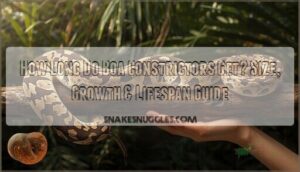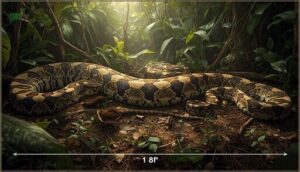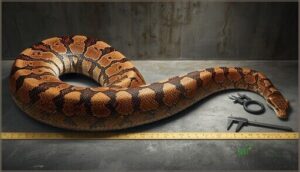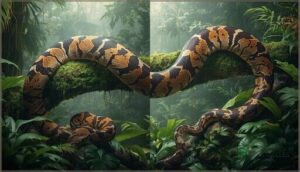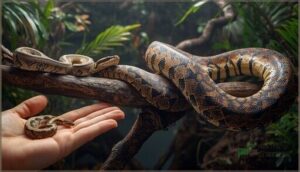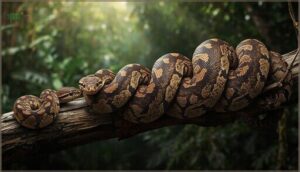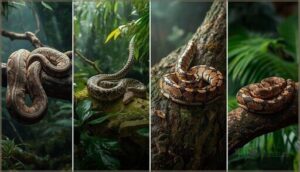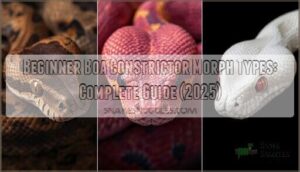This site is supported by our readers. We may earn a commission, at no cost to you, if you purchase through links.
You might think you know how big boa constrictors get, but the reality often surprises first-time owners. These powerful snakes don’t stay small for long—most adults stretch between 6 and 13 feet, with females consistently outgrowing males by several feet. That cute 18-inch hatchling you bring home will triple in size during its first year alone.
Understanding their growth patterns and lifespan, which can reach 30 years or more in captivity, helps you prepare the right enclosure, budget for decades of care, and avoid the shock many owners face when their “manageable” snake suddenly needs a 6-foot enclosure. Your boa’s final size depends on genetics, diet, and sex—factors you can anticipate but not fully control.
Table Of Contents
- Key Takeaways
- How Long Do Boa Constrictors Get?
- Boa Constrictor Lifespan Overview
- Growth and Development Stages
- Species Variations in Size and Lifespan
- Care Factors Impacting Size and Longevity
- Frequently Asked Questions (FAQs)
- How long do boa constrictors live?
- How big do boa constrictors get?
- How fast do boa constrictors grow?
- When do boa constrictors reach sexual maturity?
- How do boa constrictors work?
- Are boa constrictors a snake?
- How long is a full grown boa constrictor?
- How long does it take for a boa to reach full size?
- How big should a 2 year old boa be?
- How long do boa constrictors live as pets?
- Conclusion
Key Takeaways
- Most adult boa constrictors reach 6 to 13 feet in length, with females consistently outgrowing males by several feet—that cute 18-inch hatchling will triple in size during its first year alone.
- Your boa constrictor can live 25 to 40 years in captivity with proper care, making it a decades-long commitment that requires planning for space, veterinary costs, and consistent husbandry throughout its life.
- Growth rates peak during the first three years, then slow dramatically after sexual maturity around ages 3 to 5, meaning your enclosure needs should account for rapid juvenile expansion followed by gradual increases.
- The right combination of enclosure size (at least 6 feet for adults), proper temperature gradients (75-92°F), appropriate feeding schedules, and regular veterinary care directly determines whether your boa reaches its full size potential and maximum lifespan.
How Long Do Boa Constrictors Get?
Boa constrictors grow larger than many people expect, with size varying based on sex, diet, and genetics. Most adults reach between 3 and 13 feet, though females generally outgrow males by several feet.
Understanding their potential size helps you prepare for the space and care these snakes need throughout their lives.
Average Adult Length
Most adult boa constrictors reach 10.5 to 13.5 feet in captive lengths, though growth curves show variation. Sexual dimorphism means females generally stretch 11 to 13.5 feet, while males average 8 to 11 feet. Qualitative searching approaches are iterative and theory-driven, contrasting with linear quantitative approaches.
You’ll notice:
- Neonates start at just 12 to 20 inches
- Typical average length depends on diet and care
- Size plateaus around ages 4 to 5
Maximum Recorded Length
The longest verified boa constrictor measured 13 feet 2 inches, though unusual specimens approaching 15 feet have been reported. Length verification remains challenging in the wild, where most adults reach 6 to 9 feet. Subspecies extremes vary considerably—captivity influence plays a role, with some individuals nearing 11 feet under ideal care. Measurement accuracy depends on proper handling techniques during assessment.
Researchers use qualitative data analysis to understand various phenomena.
Size Differences by Sex
You’ll notice sexual dimorphism in boa constrictor biology right away—females consistently outgrow males across most subspecies. Female size advantage becomes clear in captivity: females usually reach 8–12% longer than males under similar care.
Maturity size differs too, with females reaching 12–14 feet versus males’ 8–10 feet. However, geographic variation means some populations show minimal differences in boa constrictor habitat-specific measurements.
Growth Rate and Stages
When you bring home a baby boa constrictor, you can expect rapid juvenile growth—about 3–4 feet in the first year. Growth trajectories taper after 24 months as they approach a maturity timeline around 3–4 years.
Captive growth shows these snakes reaching typical maximum lengths of 6–10 feet, though some hit impressive sizes beyond that with proper boa constrictor care and nutrition.
Boa Constrictor Lifespan Overview
Understanding how long your boa constrictor might live is just as important as knowing how large it will grow. These snakes can be long-term companions, but their lifespan varies depending on whether they’re in the wild or living in your home.
Let’s break down what you can expect in different environments and what factors play the biggest role in longevity.
Lifespan in The Wild
In their natural environment, boa constrictors generally live 20 to 30 years, though wild survival rates depend heavily on habitat conditions and longevity factors.
Juvenile mortality is high—only 20 to 30% of hatchlings reach their first year. Environmental stressors, habitat fragmentation, and disease incidence all affect lifespan in wild living populations.
Maintaining ecological balance helps these resilient predators achieve their full lifespan potential.
Lifespan in Captivity
Under captive care, you’ll find boa constrictors usually live 20 to 30 years, though some individuals surpass 40 years with ideal conditions. Females generally outlive males by 2 to 5 years across documented cases.
Annual mortality rates stay under 5% in well-maintained environments but rise to 10–15% when conditions falter.
Species lifespan averages vary—smaller taxa reach 15–25 years, while larger forms commonly achieve 25–40 years with proper captive animal management.
Factors Affecting Longevity
Your boa constrictor’s lifespan hinges on several controllable factors. Dietary impact proves critical—appropriately sized meals prevent obesity while meeting nutritional needs.
Captive husbandry, including temperature gradients between 24–32°C and 60–80% humidity, reduces environmental stressors.
Genetic predisposition influences disease prevention outcomes, though regular veterinary screenings and parasite control extend reptile lifespan considerably.
Well-managed captive care consistently adds 5–15 years compared to neglected conditions.
Lifespan by Species
Different boa species show distinct longevity patterns. Red-tailed boas often reach 20–30 years in captivity, occasionally hitting 40. Colombian boas generally live 15–25 years, while rainbow boas average 15–25 years with good husbandry impact. Kenyan sand boas commonly reach 20–25 years.
These species comparison figures reflect captive vs. wild differences, where genetics influence and proper reptile lifespan management prove essential for animal longevity.
Growth and Development Stages
Understanding how boas grow from hatchlings to full-sized adults helps you know what to expect as your snake matures. Growth doesn’t happen at a steady pace—your boa will go through distinct stages that depend on factors like feeding and overall health.
Let’s look at the key development phases your boa constrictor will experience from birth to adulthood.
Size at Birth and Juvenile Growth
When your boa constrictor gives birth, you’ll see 12–24 live babies, each roughly 45–60 cm long. That’s just the starting point. During their first year under captive conditions, these neonates can stretch to 1.0–1.2 meters. Here’s the growth rate breakdown:
| Age Range | Typical Length | Growth Rate |
|---|---|---|
| Birth | 45–60 cm | N/A |
| Year 1 | 1.0–1.2 meters | 40–60 cm/year |
| Years 2–3 | 1.5–2.5 meters | 20–30 cm/year |
Sexual dimorphism becomes visible around 2–3 years when females develop noticeably thicker bodies.
Time to Maturity
Sexual maturity age arrives when your boa constrictor reaches about 2.4–3.0 meters, between 3–5 years. Growth rate factors like temperature (24–32°C best), humidity (60–80%), and feeding frequency determine how quickly this turning point comes.
Environmental impact matters—captive vs. wild conditions can shift maturity timing by a full year. Size at maturity varies, with females maturing later than males due to their larger final dimensions.
Influence of Diet on Growth
Your boa constrictor’s diet directly shapes how fast and how large it grows. Prey size and feeding frequency boost growth rates—larger meals at regular intervals push weight gains between 5–12 grams monthly during juvenile stages.
Diet composition matters too: balanced protein, fat, and calcium support skeletal development. Overfeeding risks obesity and organ stress, so stick to appropriate portions.
Snake feeding and nutrition aren’t guesswork—they’re the foundation of healthy reptile nutrition.
Typical Growth Timeline
You can expect a predictable pattern: hatchlings stretch from 25–35 cm at birth, then add 12–25 cm each year through the juvenile stage.
By year three or four, your boa hits maturity—around 1.2–1.8 m in captive care.
After that, growth slowdown kicks in, dropping annual gains to just 5–20 cm as diet and animal reproduction and growth priorities shift toward lifespan maintenance.
Species Variations in Size and Lifespan
Not all boa constrictors are created equal with respect to size and longevity. Different species have their own unique characteristics that set them apart from one another.
Let’s look at how four popular types of boas compare regarding growth and lifespan.
Red-Tailed Boa Constrictor
One of the most popular Boa constrictor species in captivity, the red-tailed boa usually reaches 6–8 feet in length. You’ll notice sexual dimorphism: females grow 20–30% larger than males. Their growth rate slows after maturity, adding just 6–12 inches annually. While wild averages stay around 5–7 feet, captive size can occasionally exceed 9 feet. Maximum length records reach approximately 11 feet, though that’s rare.
Key facts about red-tailed boas:
- Females consistently outsize males in both length and girth
- Growth depends heavily on nutrition and feeding consistency
- Adult size usually stabilizes between 2–4 years
- Wild specimens rarely match captive size potential
- Choice individuals may approach 11 feet under prime care
Colombian Boa Constrictor
Colombian boas exhibit distinct size variations between wild and captive environments. In the wild, they average 8–10 feet, while captive specimens typically measure 6–9 feet. Sexual dimorphism is evident, with females growing 10–12% longer than males. Growth rates peak during years 2–5, and adults reach maturity around 4–6 years under consistent feeding regimes. In rare cases, maximum lengths can approach 12–13 feet.
| Factor | Wild vs. Captivity |
|---|---|
| Average Length | 8–10 ft (wild), 6–9 ft (captive) |
| Maximum Length | 12–13 ft (documented) |
| Lifespan | 15–20 yrs (wild), 25–30 yrs (captive) |
| Sexual Dimorphism | Females 10–12% larger |
| Maturity Age | 4–6 years with proper feeding |
Consistent reptile care and appropriate feeding regimes significantly enhance the health of Colombian boas, positively influencing both their size potential and longevity.
Kenyan Sand Boa
The Kenyan sand boa stands apart from its larger boa constrictor relatives, reaching only 12–24 inches in captivity. Sexual dimorphism is modest—females average 18–24 inches, while males measure 12–18 inches.
Growth milestones include 5–8 inch hatchlings that gain roughly 3–6 inches annually under suitable husbandry. Wild variations remain smaller, and lifespan generally spans 15–20 years with proper reptile care supporting snake health.
Rainbow Boa
Rainbow Boa constrictors display distinct species variations, generally reaching 4–5 feet in captivity while wild lifespan averages 8–12 years. Growth milestones show 12–18 inch neonates that gain 6–12 inches during their first year. Captive size occasionally exceeds 6 feet under ideal care impacts.
Reptile longevity in captivity extends to 15–20 years when you provide proper husbandry supporting snake health.
Care Factors Impacting Size and Longevity
Your boa constrictor’s size and lifespan aren’t set in stone—they depend heavily on the care you provide. The right environment, proper nutrition, and consistent health monitoring make the difference between a snake that barely reaches its potential and one that thrives for decades.
Your boa’s size and lifespan depend on the care you provide—proper environment, nutrition, and health monitoring make all the difference
Let’s break down the three key care factors that directly impact how large your boa grows and how long it lives.
Enclosure and Environmental Needs
Your boa’s enclosure directly shapes its growth potential and overall health. You’ll need at least 6 feet of space for adults, with temperature gradients from 75-92°F and humidity levels around 60-70%. Choose safe substrate types like cypress mulch, and provide hiding spots for security.
This captive environment mirrors tropical forests, supporting proper animal husbandry and best snake care throughout your boa’s habitat.
Nutrition and Feeding Practices
Feeding your boa constrictor the right prey size—about 10-15% of its body weight—prevents growth abnormalities and obesity that can shorten its life. You’ll want to feed juveniles every 5-7 days and adults every 10-14 days.
As carnivores, they thrive on prey diversity like mice, rats, and rabbits. Monitor your snake’s feeding habits and body condition to guarantee proper nutritional status throughout its development.
Veterinary Care and Health Maintenance
Regular veterinary care can mean the difference between a 15-year boa constrictor and one that thrives for 30 years. Preventative care and proper husbandry directly influence your boa snake’s lifespan and care success.
Veterinary care for reptiles should include:
- Disease management for respiratory infections and metabolic issues
- Parasite control through regular fecal screenings
- Injury treatment for wounds or scale damage
- Health checkups annually for your boa constrictor
Professional reptile pet ownership requires vigilance in monitoring your reptiles’ overall condition.
Frequently Asked Questions (FAQs)
How long do boa constrictors live?
Think of a pet that spans decades—not just years. In captivity, your boa constrictor can reach 25–40 years with proper husbandry, while wild longevity commonly ranges from 20–30 years.
How big do boa constrictors get?
Most adults stretch 6–10 feet, with females usually 10–15% larger than males. Growth rate peaks during the first three years. Juveniles hatch at 12–24 inches and mature around age four.
How fast do boa constrictors grow?
Juvenile growth occurs rapidly in the first year, with boas gaining 6–12 inches annually. Growth factors like temperature and captive growth conditions influence how quickly they reach maturity around 2–4 years.
When do boa constrictors reach sexual maturity?
Female boa constrictors usually reach sexual maturity between 2 and 3 years of age. Size at maturity usually ranges from 80 to 120 centimeters, though diet influence and captive breeding practices can accelerate growth.
How do boa constrictors work?
Constriction mechanics are surprisingly straightforward—your boa wraps around prey and tightens with each exhale, suffocating rather than crushing. Heat-sensing pits along their jaw detect warm-blooded targets, while ovoviviparous birth means live young.
Are boa constrictors a snake?
Yes, boa constrictors are snakes—specifically, they belong to the Boidae family within reptile classification. Snake evolution placed them among constrictor snakes, distinguished by unique boa characteristics like live birth and specialized jaw structure for swallowing prey whole.
How long is a full grown boa constrictor?
Adult boa constrictors usually reach 6 to 12 feet in length, though some individuals grow longer. Females usually measure 1 to 2 feet more than males at full size.
How long does it take for a boa to reach full size?
Most boas don’t reach full size overnight—growing up takes time. Your boa usually hits adult dimensions within two to four years, depending on diet quality, temperature stability, and individual genetics influencing captive growth rates and sexual maturity time.
How big should a 2 year old boa be?
By age two, your boa constrictor should measure between 3 and 4 feet in length. Growth factors like diet and sex differences can greatly influence this typical size range.
How long do boa constrictors live as pets?
With proper care, your pet boa constrictor can be a decades-long companion, usually living 25–30 years in captivity—some even reaching their mid-30s when provided ideal husbandry and regular veterinary attention.
Conclusion
You won’t regret planning ahead once you see how fast your boa grows. Knowing exactly how long boa constrictors get—and how their size shifts with sex, species, and care—keeps you prepared for decades of commitment.
These snakes aren’t impulse pets; they’re long-term companions that demand space, resources, and patience. Start with the right enclosure size now, feed responsibly, and you’ll avoid scrambling for upgrades when your six-footer outgrows its home.

